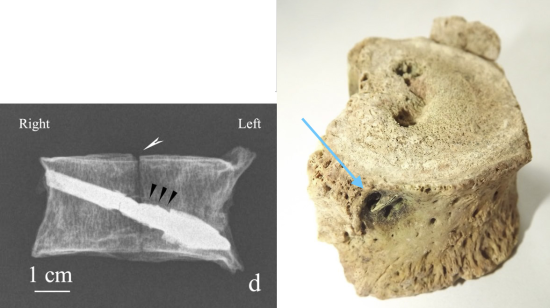Kristina Killgrove
Source - http://www.forbes.com/sites/kristinakillgrove/2015/06/08/bronze-arrowhead-embedded-in-spine-shows-elite-iron-age-warrior-survived-battle/
In an elite Early Iron Age burial from central Kazakhstan, the remains of an early Scythian nomad came to light. The bones were scattered and some had disappeared over the millennia, but when archaeologists put the pieces back together, they noticed something few researchers have seen before: a metal arrowhead wedged into the spine.
When the kurgan or mound burial at a site called Koitas was excavated, from it emerged the bones of a 25-45-year-old man, carbon dated to the 7th to 6th centuries BC. He stood about 5’9”, tall for the time and likely reflecting his elite upbringing and access to necessary resources. One of his ribs revealed a long-healed fracture, and his spine had started to show the passage of time, with the beginning of osteoarthritis.
In his lower spine, just above the small of his back, archaeologists Svetlana Tur,Svetlana Svyatko, Arman Beisenov, and Aleksei Tishkin found an arrowhead. Most times, particularly in antiquity, a piercing injury to the spine would have killed a person nearly instantaneously. But this elite Scythian survived, and the bone of his eleventh thoracic vertebra healed around it.
 Left image shows a CR scan of the vertebra with bronze arrowhead embedded. Right image shows the bone healing around the arrowhead (arrow). (Photos used with kind permission of Tur and colleagues.)
Left image shows a CR scan of the vertebra with bronze arrowhead embedded. Right image shows the bone healing around the arrowhead (arrow). (Photos used with kind permission of Tur and colleagues.)
Tur and colleagues used computed radiography and computed tomography to peer inside the vertebra to get a better look at the arrowhead. The CT scan showed it was triangular in cross-section and broken, probably on impact with the bone after it was fired. Based on how the object was positioned in the bone, the researchers think the arrow flew at him from the right and from above, at an angle. Further analysis using X-ray fluorescence revealed the arrowhead was made of copper alloy with a high tin content. Fortunately for this elite nomad, the arrowhead did not have a high lead content in the alloy, as leaving a lead object in the body can cause poisoning.
Based on a comparison with other arrowheads from the Early Iron Age in Europe and Asia, Tur and colleagues believe this is military in form. The man got hit, perhaps in battle, and someone pulled out the wooden shaft of the arrow, leaving the metal head lodged in his spine. While this type of injury is often fatal because of hemorrhage orperitonitis, in this case, the man survived long enough for his bone to heal and the metal to start to corrode.
There appears to be no evidence in this case of any medical care afforded to this man, but there are few bones remaining from the skeleton. It is possible that other bones showed additional injuries or treatment. Considering this man’s history of surviving a rib fracture and a metal arrowhead embedded in his spine, though, he may have been tough and used to the pain.
 Scythian king outfit reconstruction drawing, showing one way this man could have been outfitted. Nikopol district. (Image by Palukopa, via Wikimedia Commons.)
Scythian king outfit reconstruction drawing, showing one way this man could have been outfitted. Nikopol district. (Image by Palukopa, via Wikimedia Commons.)
For more information on this fascinating case, see S. Tur and colleagues’ article, “An exceptional case of healed vertebral wound with trapped bronze arrowhead: analysis of a 7th-6th c. BC individual from Central Kazakhstan,” in the International Journal of Osteoarchaeology.